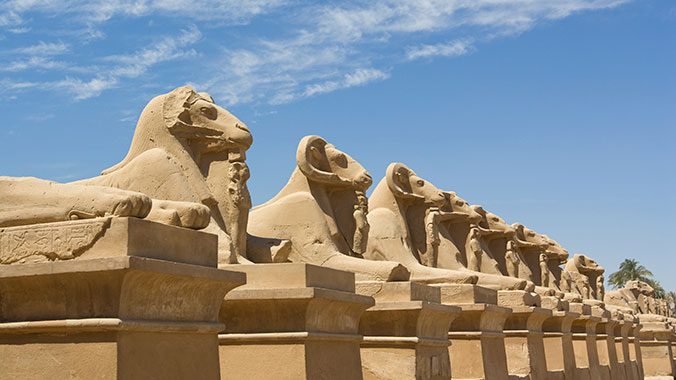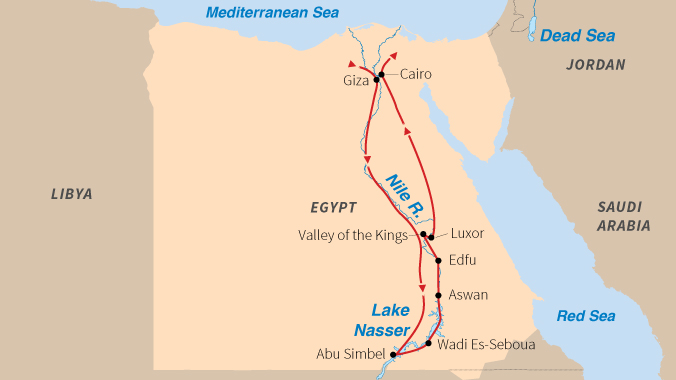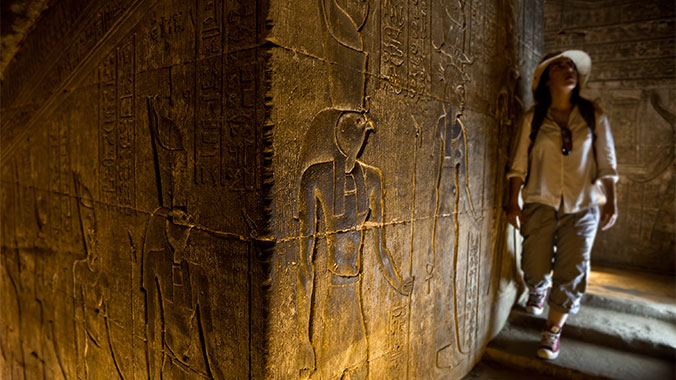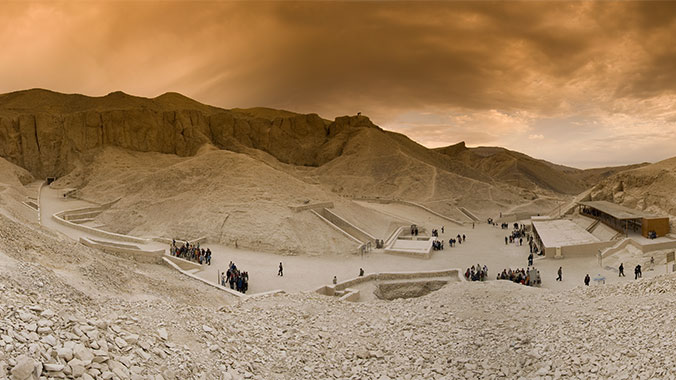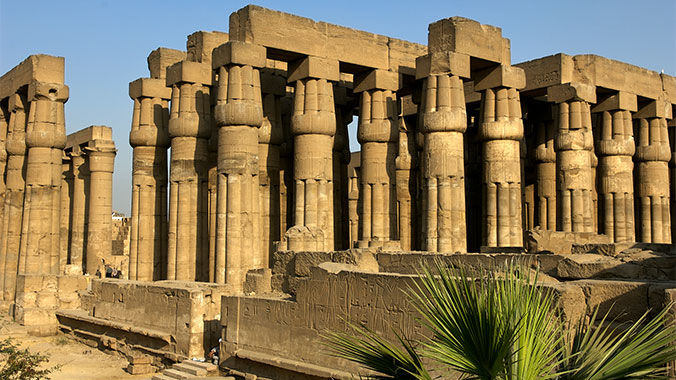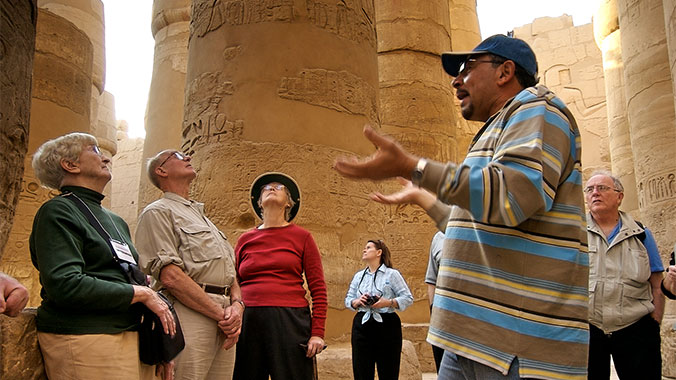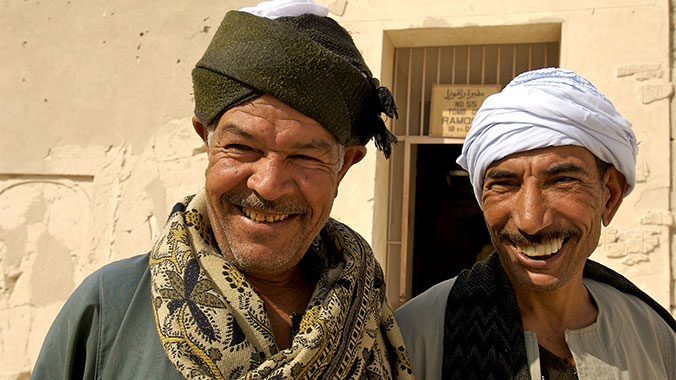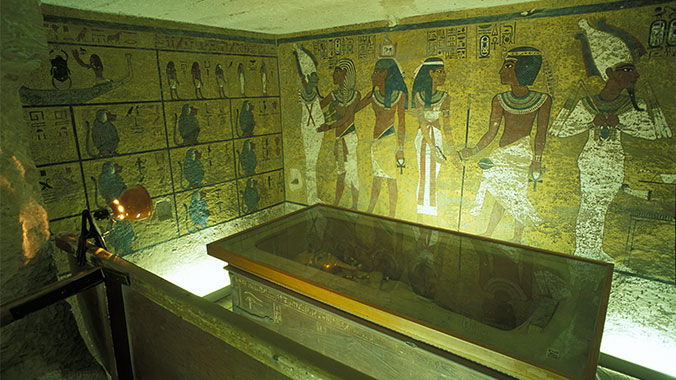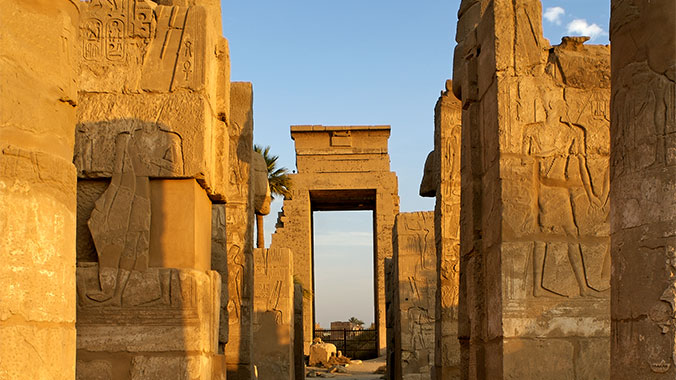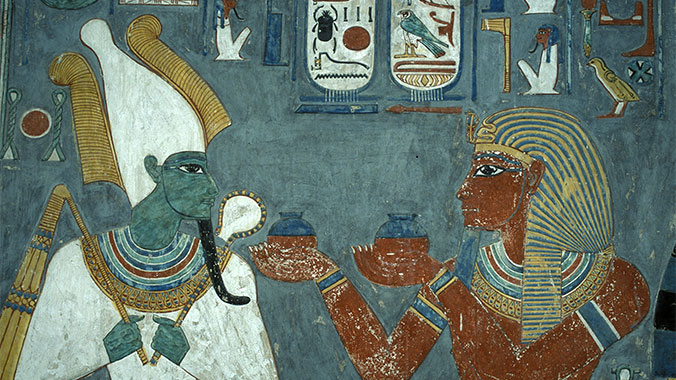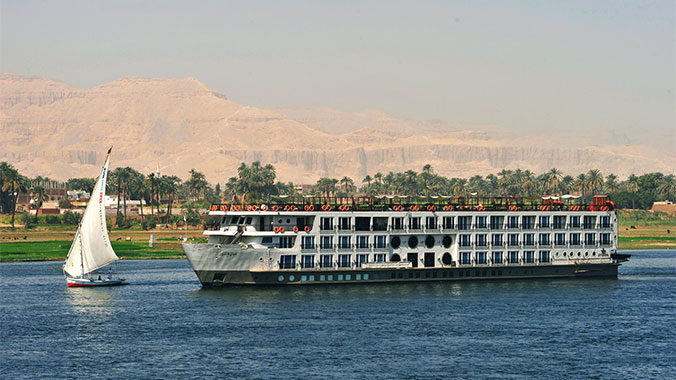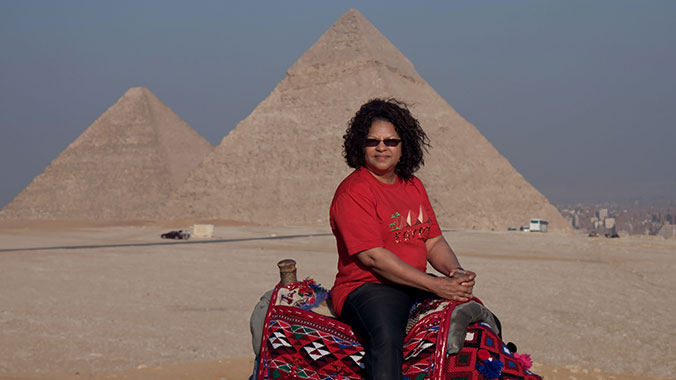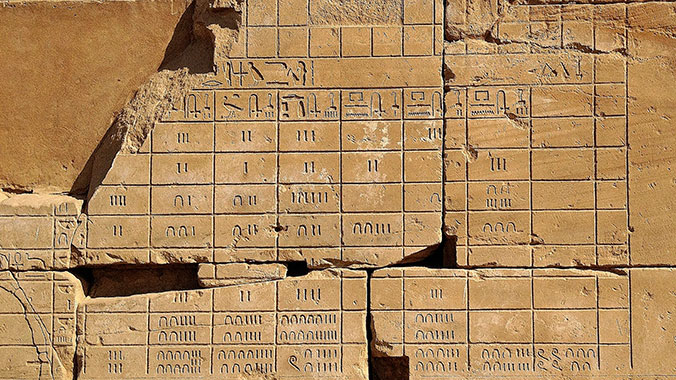Egypt
Egyptian Odyssey: Cairo, the Nile and Lake Nasser
Program No. 18774RJ
Join an Egyptologist for an insider’s understanding of this mysterious nation, learning about iconic sites, ancient communities and hidden treasures.
Itinerary
While we make every effort to ensure the accuracy of our published materials, programs are typically advertised more than a year prior to their start date.
Read More.
All itineraries and excursions are subject to change. Weather and water conditions may affect the progress of the ship, and we may miss ports if it is not safe to dock. The operators reserve the right to change the content and duration of excursions without prior notice and so the cruise itinerary should always be regarded as provisional. Whenever possible, Road Scholar’s published daily schedule will indicate port arrival and departure times. Prior to departure, if there is a major change, we will make every effort to alert you. For less significant changes, we will update you during orientation. Thank you for your understanding.
Duration
15 days
14 nights
What's Included
38 meals (
13B, 12L, 13D
)
4 expert-led lectures
26 expert-led field trips
2 flights during the program
An experienced Group Leader
13 nights of accommodations
Taxes and customary gratuity
Road Scholar Assurance Plan
Day
1
In Transit to Program
Location:
In Flight
Afternoon:
Depart on overnight flights to Cairo, Egypt.
Day
2
Arrival, Check-in, Welcome Dinner
Location:
Giza
Meals:
D
Stay:
Steigenberger Pyramids Hotel
Activity Note
This program is not suitable for participants using wheelchairs, scooters, walkers, or other mobility assistance devices.
Afternoon:
Check in to your hotel and take some time to relax and settle into your rooms. Later in the afternoon, we will meet our Study Leader and fellow Road Scholars ahead of dinner. This program is not suitable for participants using wheelchairs, scooters, walkers, or other mobility assistance devices. Thank you for your understanding.
Dinner:
At the hotel.
Evening:
At leisure. Continue getting to know your fellow Road Scholars, settle in, and get a good night’s rest for the day ahead.
Day
3
Orientation, Great Pyramids of Giza, Sphinx, Egyptian Museum
Location:
Giza
Meals:
B,L,D
Stay:
Steigenberger Pyramids Hotel
Activity Note
Today’s activities include up to three miles of walking on uneven and rough terrain. It could take up to 30 minutes of standing at each site in hot conditions under the sun with no shade. The visit to the museum will be approximately 2-3 hours and includes various steps without railings to the first floor. Please note that the museum does not have air conditioning, so it gets very warm indoors. The Grand Egyptian Museum opening is postponed as many artifacts are still in the Egyptian Museum.
Breakfast:
At the hotel.
Morning:
Orientation. The Study Leader will greet everyone and lead introductions. We will review the up-to-date program schedule, discuss roles and responsibilities, logistics, safety guidelines, emergency procedures, and answer questions. Our experienced and knowledgeable Group Leader will also serve as our Study Leader, presenting lectures and conducting field trips. Periods in the schedule designated as “Free time” and “At leisure” offer opportunities to do what you like and make your experience even more meaningful and memorable according to your personal preferences. The Group Leader will be happy to offer suggestions. Program activities, schedules, personnel, and indicated distances or times may change due to local circumstances/current conditions. In the event of changes, we will alert you as quickly as possible. After the morning orientation, led by our Egyptologist, we will explore the most renowned sites of Egypt: the Great Pyramids of Giza and the Sphinx. Start with an exploration of the Valley of Giza, a marvel of architectural prowess. The three largest pyramids in the valley consists of the Great Pyramid of Khufu, the Pyramid of Khafre, and the Pyramid of Menkaure – all tombs dedicated to different Egyptian kings. We will then head to visit the Sphinx of the Giza Plateau, the most famous sphinx in the world. This iconic statue has been guarding the necropolis for centuries and is believed to depict the face of pharaoh Khafre. Enjoy a wonderful opportunity to see the sites from a panoramic viewpoint and experience a unique short camel ride.
Lunch:
At the hotel.
Afternoon:
We will enjoy a visit to the Egyptian Museum, the oldest archeological museum in the Middle East, which houses the largest collection of pharaonic antiquities in the world. The museum displays an extensive collection spanning from the Predynastic Period to the Greco-Roman era. The museum also houses the splendid statues of the great kings Khufu, Khafre and Menkaure, whose tombs lie in the pyramids of the Giza plateau. An extensive collection of papyri, sarcophagi and jewelry, among other objects, completes this uniquely expansive museum. NOTE: As of June 14, 2025, the Egyptian government has announced that the full opening of the Grand Egyptian Museum (GEM) has been postponed. Grand Egyptian Museum is currently only partially open and many of Egypt’s most iconic artifacts—including the famous golden mask of Tutankhamun—remain on display at the Egyptian Museum in Cairo. So, we will visit the Egyptian Museum to see these valuable artifacts. After our visit we will return to the hotel where we will enjoy a presentation titled “Egypt and the Nile” by a local professor from Cairo University.
Dinner:
At the hotel.
Evening:
At leisure.
Day
4
Dahshur & Saqqara
Location:
Giza
Meals:
B,L,D
Stay:
Steigenberger Pyramids Hotel
Activity Note
Today’s activities include up to two miles of walking on uneven and rough terrain. It could take up to 30 minutes standing at each site.
Breakfast:
At the hotel.
Morning:
We will begin our day with a field trip to Dashur, a necropolis of the Old Kingdom. This site houses some of the oldest pyramids of Egypt, which were commissioned in the 4th dynasty by Pharaoh Sneferu around the year 2600 BC. Dashur is am extremely important site because it shows the trials and errors of ancient Egyptians in transitioning from step-sided pyramids to smooth sided pyramids. Among some of the key attractions is the Bent Pyramid, the first attempt at a smooth sided pyramid which was unsuccessful due to architectural miscalculations, and the Red Pyramid, the first successful smooth sided pyramid and the resting place of King Sneferu.
Lunch:
At a local restaurant.
Afternoon:
After lunch we will set out to explore Saqqara, the necropolis for the ancient Egyptian capital of Memphis. Here we will see the Step Pyramid complex of King Djoser, built more than 4700 years ago and considered the oldest stone structure on Earth. This pyramid was built for the burial of Pharaoh Djoser and was designed and commissioned by his vizier and high priest of the god Ra, Imhotep. Next, we will visit the Pyramid of Teti. Although the original height of this pyramid is believed to have been 172 feet, the preservation above ground is poor and now mostly resembles a small hill. Inside however, we will see some marvelous pyramid texts inscribed around the walls of the burial chamber and inner corridors. These are some of the oldest texts found belonging to the Old Kingdom, around 2300 BC. Although Saqqara is home to many royal burials, this was not a royal necropolis exclusively. Among many of the tombs found in this valley we will find the tomb of Kagemni, chief justice and vizier who served under the reign of Pharaoh Teti. While kings began to be buried in pyramids during the Old Kingdom, Kagemni’s tomb is still in the old “stone bench” shape tomb known as a mastaba. After our visit, we will return to the hotel where we will enjoy a presentation by a local scholar regarding Egypt and the Nile.
Dinner:
At the hotel.
Evening:
At leisure.
Day
5
Flight to Aswan & Abu Simbel
Location:
Abu Simbel
Meals:
B,L,D
Stay:
MS Omar El Khayam
Activity Note
This day includes an early morning start. Today’s activities include up to two miles of walking on uneven and rough terrain. It could take up to one hour of standing at each site in hot conditions under the sun with no shade. At the pier there are between 40-60 steps to reach the ship. The flight from Cairo to Aswan is approximately one and a half hours long.
Breakfast:
Boxed breakfast from the hotel.
Morning:
We will depart the hotel early and transfer by coach to the airport for a flight to Aswan. Upon arrival, we will board a coach and drive to Abu Simbel. Check-in at the ship.
Lunch:
On board.
Afternoon:
Led by your Egyptologist, discover the Temple of Abu Simbel. Abu Simbel was first reported by J. L. Burckhardt in 1813, when he came over the mountain and only saw the facade of the great temple as he was preparing to leave that area via the Nile. The two temples, that of Ramesses II primarily dedicated to Re-Harakhte and that of his wife, Nefertari dedicated to Hathor, became a must see for Victorians visiting Egypt, even though it required a trip up the Nile, and often they were covered deeply in sand, as they were when Burckhardt found them.
Dinner:
On board.
Evening:
Join your Group Leader for a walk to enjoy a once in a lifetime experience in Egypt with a spectacular sound and light show at Abu Simbel, which will convey to you the time of the pharaohs. .
Day
6
Kasr Ibrim & Temple of Amada
Location:
Wadi El Sebou
Meals:
B,L,D
Stay:
MS Omar El Khayam
Activity Note
Today’s activities include up to two miles of walking on uneven and rough terrain. It could take up to two hours of standing at each site in hot conditions under the sun with no shade. Participants will have to climb in and out of tender boats to reach the shore and to return to the cruise ship.
Breakfast:
On board.
Morning:
While we cruise we will gather for an overview and viewing of Kasr Ibrim from the sun deck. Prior to the construction of the High Dam south of Aswan, Kasr Ibrim stood on the highest of three headlands on the east bank of the Nile some 70 meters above the river. Today, it is usually an island, though at times the lake has revealed a land bridge joining the island to the shore. This complex is the last on Lake Nasser prior to Abu Simbel, but visitors may only gaze upon it from the comforts of a Lake Nasser Cruise boat, as it is no longer accessible to explore. However, the Egypt Exploration Society does continue work on the site, as they have since 1959. Kasr is Arabic for "fort," so in English its name means Fort of Ibrim. Its name is ultimately derived from its ancient Meroitic name, Pedeme. In classical texts it was called Primis and in Coptic, Phrim, which was corrupted to Ibrim in Arabic. The exact origin of the site is really not known, though it may have originally been built up during the Middle Kingdom when the 12th-dynasty kings were establishing control of the trade route along the Nile. However, the earliest archaeological evidence for the site dates to about 1000 BCE, considerably after the end of the Middle Kingdom. Obviously, its site so high above the Nile was recognized for its strategic importance early on and in fact there were fights for its possession throughout the centuries, even into modern times.
Lunch:
Onboard.
Afternoon:
We will take a tender to explore the Temple of Amada, which includes important historical inscriptions and is the oldest of the Lake Nasser temples. One inscription carved on a stela on the rear wall of the sanctuary in the third year of Amenhotep II describes an Egyptian military campaign into Asia, and his bringing back the bodies of rebel chieftains to hang on the walls of Thebes and one on the prow of his ship sailing through Nubia as a warning. Another, carved on a stela on the northern side of the entrance doorway describes a Libyan invasion of Egypt in the fourth year of Merenptah, the son of Ramesses II. After our visit, we will take a tender back to our cruise ship. We will then sail to Wadi El Sebou.
Dinner:
Onboard.
Evening:
At leisure.
Day
7
Temples of Wadi El Sebou
Location:
Aswan
Meals:
B,L,D
Stay:
MS Omar El Khayam
Activity Note
Today’s activities include up to one and a half miles of walking on uneven ground and rough terrain. It could take up to two hours standing at each site in hot conditions under the sun with no shade. Participants will have to climb in and out of tender boats to reach the shore and to return to the cruise ship.
Breakfast:
On board.
Morning:
We will start the day by taking a tender to the shore to explore Wadi El Sebou, also known as the Valley of the Lions. Among the most prominent structures in this archeological complex is a 19th century temple built by Ramesses II in dedication to the god Amun and Ra-Horakhty. After our visit, we will return to the ship and set sail for Aswan.
Lunch:
On board.
Afternoon:
Enjoy some free time onboard to relax and prepare for our disembarkation the following morning. As we continue to sail towards Aswan, please note that we will cross Lake Nasser. One of the largest man-made lakes in the world, Lake Nasser is approximately 310 miles in length, 1550 square miles in size, and in some places, can reach a depth of 600 feet. The lake was created in the 1960s when the world-famous High Dam was built. It is named for Gamal Abdel Nasser, president of Egypt from 1956 to 1970.
Dinner:
On board.
Evening:
At leisure.
Day
8
Philae Temple, The Unfinished Obelisk, & The Nubia Museum
Location:
Aswan
Meals:
B,L,D
Stay:
MS Minerva
Activity Note
Today’s activities include up to one and a half miles of walking on uneven ground and rough terrain. It could take up to one hour standing at each site in hot conditions under the sun with no shade. During field trips there are approximately 40 steps without railings over hilly and uneven ground, and there are 20-40 steps to reach the ship. Participants will have to climb in and out of motorboats to reach Philae Temple and return.
Breakfast:
On board.
Morning:
We will disembark and depart by coach for the High Dam of Egypt. Also known as the Aswan Dam, this world famous dam was an engineering miracle when it was built in the 1960s. It contains eighteen times more material used to build the Great Pyramid, and provides electricity and irrigation for the whole of Egypt. The old Aswan Dam, built six kilometers down the river by the British in 1898 provides a wonderful view for visitors, from which you can gaze across Lake Nasser, the huge reservoir created when the dam was built. We will continue our morning with a visit to Philae Temple. “Philae” is a Greek approximation of what is described in hieroglyphic texts as “Pilak”, and refers to the “island of the time of Re”, i.e. the time of creation. However, what we refer to today as Philae is the main temple complex relocated from that ancient island to the island of Agilika in the 1960s as a conservationist move to avoid the site’s loss due to flooding by the High Dam. This temple was the center of the cult of goddess Isis and her connection with Osiris, Horus, and the Kingship, during the Ptolemaic period of Egyptian history. We will then head to the unfinished Obelisk, located in the Northern Quarry. Possibly intended as a companion to the Lateran Obelisk (originally in Karnak, but now in Rome) it would have weighed over 2.3 million pounds and would have been the world’s largest piece of stone ever handled. However, a crack in the stone occurred, which caused it to be abandoned where it lays today. Tools left by its builders have given us much insight into how such work was performed. After this eventful morning, we will depart by coach and check in to our new cruise ship.
Lunch:
On board.
Afternoon:
We will transfer by coach for an afternoon visit to the Nubia Museum. “Nubia” means gold in the hieroglyphic language of ancient Egypt, and is the name given to the region by the Nile that extends from Aswan in Egypt to Khartoum in Sudan. This “Land of Gold” was known for its monumental treasures, many of which are in display at the Nubia Museum today. All 3,000 pieces exhibited in the museum reflect the character of the Nubia over history and display how it merged with both Islamic civilization and the mother civilization of Egypt.
Dinner:
On board.
Evening:
At leisure.
Day
9
Kom Ombo & Edfu
Location:
Luxor
Meals:
B,L,D
Stay:
MS Minerva
Activity Note
Today’s activities include walking up to two miles on uneven ground and rough terrain. It could take up to two hours of standing at each site in hot conditions under the sun with no shade. There are over 50 steps without railings at historic sites. This day may include rides on horse-drawn carriages, but could be substituted by a bus ride depending on availability.
Breakfast:
On board.
Morning:
We will begin our day with a visit to the well preserved Kom Ombo Temple. Built during the Ptolemaic dynasty in the 2nd century BC, this temple is highly unusual because of its symmetrical ‘double’ design. All of the rooms of the temple are duplicated, mirrored among the building’s main axis. The southern half of the building was dedicated to the crocodile god Sobek, while the northern part of the building was dedicated to falcon god Horus. During initial excavations, over three hundred crocodile mummies were discovered at this site. After our visit we will return to the ship, where we will set sail to Edfu.
Lunch:
On board.
Afternoon:
Discover Edfu, another prominent Ptolemaic period temple. Dedicated to falcon god Horus, the Temple of Edfu is one of the largest and best preserved temples in all of Egypt. The inscriptions on the walls of the temple have provided meaningful insight to the language and religion of the Hellenistic period of Egypt, as well as some of the construction techniques used by architects at the time.
Dinner:
On board.
Evening:
At leisure.
Day
10
Valley of the Queens & Hatshepsut Temple
Location:
Luxor
Meals:
B,L,D
Stay:
MS Minerva
Activity Note
Today’s activities includes up to three miles of walking on uneven ground and rough terrain. It could take up to an hour of standing at each site in hot conditions under the sun with no shade. The terrain is hilly and there are many steps without railings, especially at Hatshepsut Temple. The visit to the museum is one hour and there are some steps with railings.
Breakfast:
On board.
Morning:
We will depart by coach and cross the Nile to visit the famous Valley of the Queens. Known at the time as “Ta-Set-Neferu”, or “the place of beauty”, this site is the necropolis of the wives, daughters and sons of many Egyptian pharaohs of the 19th and 20th dynasties. Part of ancient Thebes, the burial ground includes more than 90 known tombs. After our visit to the valley, we will venture nearby to the iconic Temple of Queen Hatshepsut. A marvel of ancient architecture, this mortuary temple was built by Pharaoh Hatshepsut and dedicated to herself and the god Amun.
Lunch:
On board.
Afternoon:
After lunch, we will take a relaxing Felucca ride and sail to Gezira el Mozh. This small island in the Nile River attracts visitors every year due to its local banana plantation, which is why it is commonly referred to as “Banana Island”. We will return to the mainland and enjoy a visit to the Luxor Museum of Archeology. Opened in 1975, this museum has a small but significant collection of artifacts and statues collected from the nearby temples of Luxor and Karnak. After our visit, we will return to the ship by coach.
Dinner:
On board.
Evening:
At leisure.
Day
11
Valley of the Kings, Howard Carter House, & Luxor Library
Location:
Luxor
Meals:
B,L,D
Stay:
Pavillon Winter Luxor Hotel
Activity Note
Today’s activities include up to three miles of walking on uneven ground and rough terrain. It could take up to one hour of standing at each site in hot conditions under the sun with no shade. The terrain is hilly and there are over 50 steps without railings at the tombs in the Valley of the Kings. The visit to the library is one hour and there are up to 20 steps to enter the building.
Breakfast:
On board.
Morning:
We will disembark early to explore more of the iconic sites on the west bank of Luxor. Led by our Group Leader we will discover the Valley of the Kings, including the world-famous tomb of King Tut. This area of the west bank had been home to royal burials since 2100 BC, but it was the pharaohs of the New Kingdom period (1550-1069 BC) who began to construct elaborate tombs to reflect their newfound power and prosperity after the reunification of Egypt under Theban rule. The Valley of the Kings is home to 63 magnificent royal tombs, each unique in their own way. Before we depart the Valley of the Kings, we will enjoy a short visit to the famous Colossi of Memnon. These massive twin statues depict Pharaoh Amenhotep III, and stand in what was once the entrance to the Mortuary Temple of Amenhotep III. Unfortunately, the temple was destroyed by an earthquake shortly after its construction in 1200 BC, leaving only the famous statues behind. Stories claim that another earthquake in 27 BC damaged the foundation of the northern colossus, causing it to “sing” on various occasions – usually heard by travelers around dawn. Greek scholars and travelers quickly took to calling the statue the “colossus of Memnon” since the mythological hero of Memnon was a king in the region and said to be the son of Eos, the goddess of dawn. After these visits, we will head to the former home of the most renown Egyptologist in the world, Howard Carter. The British archeologist’s discovery of the tomb of Tutankhamun in 1922 was a world sensation, inspiring a century of books and media attention to the land of Egypt. This house, now a museum, is where Carter lived during his search and excavation of the famous tomb and includes a collection of his notes cataloguing all of his finds in the nearby Valley of the Kings.
Lunch:
At a local restaurant.
Afternoon:
After lunch we will transfer to our new hotel for check in. Enjoy some time to settle into your new rooms and relax. Later in the afternoon, we will head to the nearby library to enjoy a presentation by a local professor titled “The Opet Festival and the Ongoing Restoration Work of Luxor”.
Dinner:
At the hotel.
Evening:
At leisure.
Day
12
Karnak, Luxor Temple & Free Time
Location:
Luxor
Meals:
B,L,D
Stay:
Pavillon Winter Luxor Hotel
Activity Note
Today’s activities will include up to three miles of walking on uneven ground and rough terrain. It could take up to one and a half hours of standing at each site in hot conditions under the sun with no shade. At Karnak, there are a few steps without railings.
Breakfast:
At the hotel.
Morning:
We will spend the morning exploring the temples of Karnak and Luxor. These temples were the religious centers of the ancient city of Thebes, which is modern-day Luxor. Karnak, also known as “ipet-isut” or “the most sacred of places”, is the largest temple complex ever built by man and represents the combined achievements of thirteen centuries of builders. Among the gods venerated at this site were Amun-Re, his wife Mut, and their son Montu. Luxor Temple, also known as “ipet-resyt” or “the southern sanctuary”, was the center of one of the most important religious festivals in ancient Egypt – the Opet Festival – during which the statues of Amun-Re, Mut and Khonsu were carried from Karnak to Luxor. Some scholars have also proposed that Luxor Temple differs from other temples in the region, as they argue it was centered not on the cult of a deity or deceased pharaoh, but on the cult of the current king on Earth. Academics even argue that Luxor Temple may have been the site where many of the pharaohs of Egypt were crowned kings.
Lunch:
At a local restaurant.
Afternoon:
We will return to the hotel by coach. The rest of the afternoon is free for you to explore Luxor on your own. Your Group Leader will be happy to offer suggestions.
Dinner:
At the hotel.
Evening:
At leisure.
Day
13
Flight to Cairo, Coptic Cairo & Free Time
Location:
Cairo
Meals:
B,L,D
Stay:
InterContinental Semiramis Hotel
Activity Note
Today’s activities include up to three miles of walking on uneven ground. It could take up to one hour of standing at each site. There are 30 steps with railings to enter the Hanging Church. The flight from Luxor to Cairo is approximately one hour.
Breakfast:
At the hotel.
Morning:
We will check out of our hotel and transfer to the Luxor Airport for a flight to Cairo. Upon arrival, we will transfer via coach to the oldest part of the city, known locally as Masr al-Qadima or “Old Cairo”. Part of this area has been a stronghold of Christianity since the Roman period and is known colloquially as “Coptic Cairo”. During our visit we will enjoy a field trip to Saints Sergius and Bacchus Church (also known as Abu Serga) and the Hanging Church, two of the most famous and oldest Coptic churches in all of Egypt. The former is believed to have been built in the spot where the Holy Family rested at the end of their journey to Egypt, and is where many patriarchs of the Coptic Church have been elected and consecrated. We will continue onto Ben Ezra Synagogue, established in Coptic Cairo in 1115 in what was previously a Coptic church built in the 8th century. The building was sold to the Jewish community of Egypt in 882 and is named after prominent Jewish religious scholar Abraham Ibn Ezra. Ben Ezra Synagogue is the oldest synagogue in all of Egypt and is the place where the Cairo Geniza – the largest and most important single collection of medieval Jewish manuscripts – was discovered in 1896.
Lunch:
At a local restaurant.
Afternoon:
We will make our way to the hotel and check-in. Enjoy some time to settle into your rooms. The remainder of the afternoon is free to see and do what interests you most in Cairo. Your Group Leader will be happy to offer suggestions.
Dinner:
At the hotel.
Evening:
At leisure.
Day
14
Exploring Islamic Cairo
Location:
Cairo
Meals:
B,L,D
Stay:
InterContinental Semiramis Hotel
Activity Note
Today’s activities include up to two miles of walking on uneven ground. It could take up to one hour of standing at each site. While Egypt is not as strict in dress code as other Islamic countries, we recommend dressing conservatively when entering mosques.
Breakfast:
At the hotel.
Morning:
Today we will return to the old part of Cairo, this time to explore the Islamic heritage of the city. We will begin our day with a visit to the Mosque of Ibn Tulun, built in 879 and one of the oldest mosques in all of Africa. This mosque is the only surviving structure of the city of al-Qata’i, which served as the capital of the short-lived Tulunid dynasty from 868-905. We will then head towards Salah al-Din Square, the main city square of Islamic Cairo. Here we will enjoy a field trip to the majestic Mosque-Madrasa of Sultan Hasan, built in the mid-14th century during the Bahri Mamluk period and commissioned by Sultan an-Nasir Hasan. This imposing structure is one of the first buildings to combine a mosque with a madrasa (school) and is considered one of the finest examples of Mamluk architecture. Crossing the street we will then explore Al-Rifa’i Mosque, built in the late 19th century as a complement to its 14th century neighbor. This mosque is the burial place of multiple royal members of the Muhammad Ali dynasty. To conclude our visit we will head towards El-Moez street, the most important street of Islamic Cairo. Dating to the 10th century, El-Moez was the main street where markets and shops flourished. Today this area is still populated by multiple shops, and has a rich evidence of ancient Islamic architecture. Among one of the most popular places located on El-Moez is Khan el-Khalili Bazaar, originally founded as a center of trade during the Mamluk era. Today, this bazaar is home to many Egyptian artisans and workshops and is one of the most popular shopping districts of Cairo. After a short visit, our Group Leader will give us some time to explore this area on our own and interact with locals.
Lunch:
At a local restaurant.
Afternoon:
Enjoy some free time to continue your exploration of Cairo independently. Later in the afternoon, we will return to the hotel where we will enjoy a presentation on modern Egyptian life by a guest lecturer.
Dinner:
Farewell dinner at the local restaurant.
Evening:
At leisure.
Day
15
Program Concludes
Location:
In Flight
Meals:
B
Activity Note
We hope you enjoy Road Scholar learning adventures and look forward to having you on rewarding programs in the future. Please be in touch via the Road Scholar Social Network, where you can share memories, pictures, and comments. Best wishes for all your journeys!
Breakfast:
At the hotel.
Morning:
Depart very early in the morning for return flights. If you are returning home, safe travels. If you are staying on independently, have a wonderful time. If you are transferring to another Road Scholar program, detailed instructions are included in your Information Packet for that program. We hope you enjoy Road Scholar learning adventures and look forward to having you on rewarding programs in the future. Don’t forget to join our Facebook page and follow us on Instagram. Best wishes for all your journeys!
Please Note:
This program has itinerary variations on certain dates.

